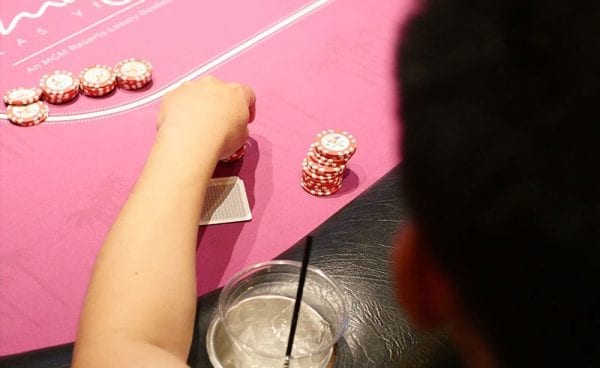One of my favorite pair of RCP videos is Doug Hull’s couplet: “How an Unstudied Player Thinks.” which PRO members can watch here and here. They feature someone who has played poker for a long time, but who has never eliminated fundamental mistakes from their game. The videos illustrate specific errors and provide an insight into why the player makes poor plays. In this article I’ll describe some mistakes I see frequently in $1/2 games and, where applicable, suggest ways they can be exploited. I’ve focused on errors that also may be made by competent $1/2 players, albeit in a less glaring form, that you might like to look for and eradicate in your own play.
The following hand was largely responsible for provoking the current article. It’s an afternoon weekday game at the Flamingo with a couple of regulars sprinkled in among the tourists. I’d just sat and didn’t recognize the players involved in this hand.
EP calls $2
MP raises to $12
BB calls $12
EP calls $12
Flop A♥9♣5♦
BB checks
EP checks
MP bets $20
BB folds
EP calls $20
Turn K♥
EP checks
MP bets $35
EP calls $35
River 4♥
EP checks.
MP glares at the A♥9♣5♦K♥4♥ board, says “I can’t bet,” and tables A♠K♠.
I was so busy not falling out of my seat that I nearly forgot to do the standard commiseration head-nodding to MP who was directly on my left. “Damned hearts,” he said as he stacked his chips, presumably to make it clear precisely why he couldn’t bet the river.
I don’t discuss strategy at the table, particularly with people who may not be aware poker has strategies, but if I did I might have shared the following thoughts. The first of which is that when there are three hearts on board it matters in which order they arrived there. Add to this the fact that the A♥ flopped, thereby making it impossible that EP was holding it, and… I mean, what does EP have that beats top two? We could assume, generously, that he would limp-call pre with 8♥7♥, 8♥6♥ and 7♥6♥, that he found a call with a gutshot on the flop and then picked up the flush draw on the turn. And for our river check to make sense we must also assume that, having backed into a flush, EP would check the river. But not only is that one hell of a parlay, it ignores the far greater number of non-flush combos that both get to the river and that will pay off a river bet.
Most $1/2 players have at best a minimal hand-reading ability. All they see is that there are three hearts on board which makes a flush possible, and a flush beats top two. So they check back the river and then compound the error by tabling their hand out of turn, thereby depriving themselves and me of the information we could glean about EP’s play had he tabled his hole cards.
(Aside: Never give up free information when you don’t have to. It’s more valuable to keep people in the dark than show them how unfair the universe is when your aces get cracked. Besides, the only people who care are players who will use that information against you.)

One of the nice things about this mistake of the missed river bet is that, from our point of view, it is essentially auto-exploitable. We don’t need to do anything since when the positions are reversed we will bet the river. However, this “flushfear” is so ubiquitous, particularly in older players, that it does open up other possibilities for exploitation. Most notably, we can often use “faux flush outs” even when we don’t hold the flush draw. I am more inclined to float on two-tone flops when I can reasonably bluff the flush card when it comes in.
However, there’s another point raised by this hand. Put yourself in the position of MP when you’re checked to on the river. What range do you bet here? Sure, “it depends” on how EP plays, but for a typical $1/2 limp-caller we can clearly bet wider than top two. I think most decent players would bet A5 and A4? What about AQ? AJ?
I was pondering this question as I took my hourly walk-and-vape around the casino floor. Missing bets on the river is a costly leak in NLHE. I suspect it is a leak that many $1/2 players have, partly because of a nasty little psychological quirk.
Let’s go back to the hand. I’ll put myself in the seat of the pre-flop raiser, but this time I have A♠4♠. The board runs out the same. EP checks the river, I fire out a bet and get called. I table my hand and get shown A♦5♣ for a bigger two pair.
Oh noes! I just value-owned myself. What a silly limey dummy! And everyone else at the table saw!
It’s human nature. I suspect one reason our player with the A♠K♠ did not bet the end was because he didn’t want to look foolish if he was shown a flush, despite the fact that it was almost inconceivable that his opponent actually had one. Besides, it’s annoying, right? Wasting a bet when you could just check back.
Well, no. What’s annoying is the value you lose by failing to bet the river. Examine your own game. If you never value-own yourself, you’re not betting frequently enough for thin value.
If you follow showdowns in a typical $1/2 game you will notice that it is rare for someone to bet the river and lose. The first reason is the one just described; particularly when checked to, many players sigh in relief, check back, and table their winning hand. The second reason is that $1/2 players do not bluff enough.
Again you can run a simple self-diagnostic. When was the last time you got caught bluffing? I’ve been working on this aspect of my game and the answer for me is typically “within the last couple of sessions.” That’s almost certainly too low a frequency even at tables liberally peppered with calling stations. But if I asked this question of some Vegas regulars, they wouldn’t answer in terms of the number of sessions. Many of them if they were honest would have to name a year. There are a couple who I swear would need to go back a decade.
Again I think there is a psychological element at play. Getting caught bluffing… well, there’s that word “caught.” Thieves get caught, thus the implication is that bluffing is in some sense dishonest. Whether or not this is part of the reason some people bluff so rarely I am not sure. But the fact they do is easily exploitable. As Miller hammers home in “The Course,” fold to big bets, particularly when they are fired by nits on the turn and river.
If your table image is somewhat nit/TAG, this principle creates an obvious opportunity. If you’re the player who doesn’t enter many pots and always “has it” when the money goes in, you can almost certainly get away with more thievery than you’re currently attempting. And if you’re really adventurous… Let’s just say the number of Vegas $1/2 players who check-raise bluff the river could fit in a phone booth.
I’ve argued that $1/2 players tend to bet with too low a frequency, but one of their most exploitable errors occurs when they do manage to fire chips in the pot as the aggressor. Again it is a topic about which much has been written, but it is so endemic in low-limit live games I felt it important to mention it explicitly.
I was playing in a game with a white-haired gentleman who was extremely active for his demographic and sobriety level. Since he was in a lot of pots I paid particular attention to him. It quickly became apparent that he had two bet sizes on the flop of roughly 0.5x pot and 2x pot. Thanks to PokerSnowie and similar poker AIs, mixed strategies are attracting increasing attention, but I was willing to bet the cat that this gentleman simply had a traditional bet-sizing tell.
I changed seats while muttering about a damned draft to get closer to his left. Whenever I was in the hand with this gentleman and he made his small leads I either floated or raised if I needed to clean out players behind. In the former case I bet when checked to on the turn. After a couple of hours the gentleman left. I never got to see what type of hands he was using for these small leads because he never got to showdown, but I didn’t need to. I had seen the hands where he 2x potted the flop and they were all two-pair-plus.
Like physical tells, bet-sizing tells often require calibration with a specific player, which is a shame since this reduces the amount of time one can use for exploitation. However, the crème de la crème of bet-sizing tells seems almost universal as if it were passed down by the Poker Gods on stone tablets. It invariably occurs on the turn and is usually heralded by the bettor uttering two simple words:
“Same bet.”
Even if the player saying this has only just sat, if I am next to act I am immediately reaching for raising chips. Most commonly the bettor will make a smallish lead on the flop, glare at the board when a messy turn card comes off, and bet the identical amount as the previous street. I guess the idea is that they don’t want to check and face a bet with a hand that has been rendered weaker by the turn, so they… ah… They bet-fold instead of check-fold thereby losing more money. I guess some poker mysteries may never be fully explained.
This is one of the most common and exploitable mistakes that I see in Vegas $1/2 games. In fact it is so ubiquitous I’ve been wondering why some intelligent biscuit doesn’t reverse it by same-bet/3-betting the turn with a monster. If you ever see such a play, please let me know.
